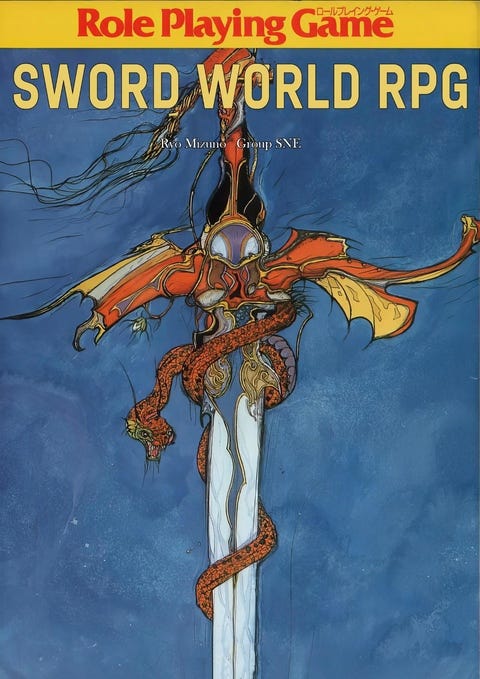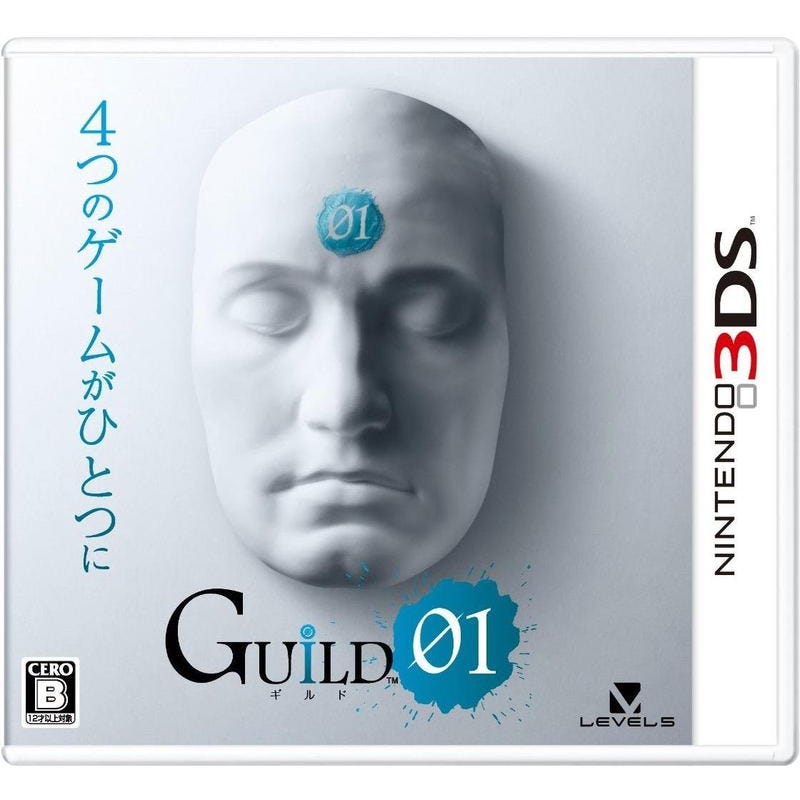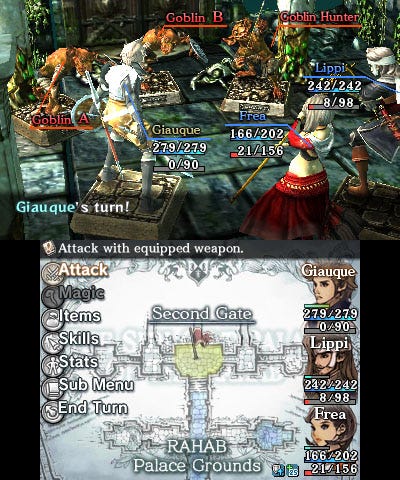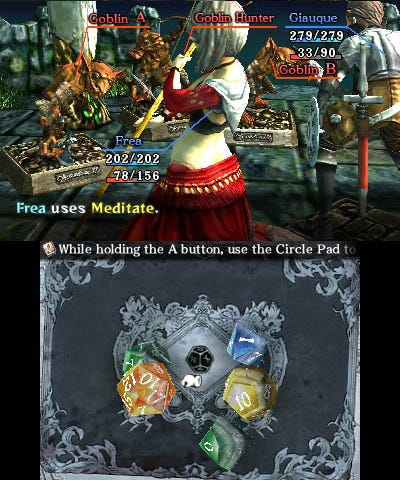Crimson Shroud, Matsuno's bite-sized lost opus

Developer: Nex Entertainment
Publisher: Level 5
Director : Yasumi Matsuno (Ogre Battle, Tactics Ogre, Final Fantasy Tactics, Final Fantasy XII)
Scenario writer: Yasumi Matsuno (Ogre Battle, Tactics Ogre, Final Fantasy Tactics, Final Fantasy XII)
Composers: Hitoshi Sakimoto
Character designers: Hideo Minaba (Lord of Arcana)
Genre: Story-driven dungeon crawler with turn based battles, an heavy emphasis on tabletop RPG elements and limited character customization due to equipments and skills being the only growth instead of levels
Progression: Linear, with new contents and a different ending available on New Game + and yet more new contents, this time akin to an ironic commentary, available on New Game ++, though unfortunately only in the Japanese version
Developer’s Country: Japan
Platforms: Nintendo 3DS
Released: 13\12\2012 (Europe)
Completed: Completed on 10\1\2013
For those of us who had learned to appreciate Yasumi Matsuno since the days of Ogre Battle, Tactics Ogre, Final Fantasy Tactics and Vagrant Story, the rollercoaster of Final Fantasy XII’s development news ended up being quite painful. Since the beginning, imagining a flagship Final Fantasy entry molded by his imagination and narrative sensibilities seemed too good to be true and, unfortunately, that impression ended up materializing when he resigned from his position as producer in 2005, four years into the game’s development and one before its release, with his original vision for the title suffering quite a number of meaningful changes that have been the object of lots of different theories and debates. It didn’t help that Matsuno spent the next few years avoiding developing RPG projects, likely because of the stressful context of his resignation, with his only work during that troubled time being the scenario for Platinum Games’ Madworld, a stark departure from everything he had worked on so far.
After returning to Square Enix to supervise Tactics Ogre’s 2010 PSP remake, it was finally time for Matsuno to work a new, original game, even if it was destined to be a much smaller experience than many of us would have expected, or hoped for. Crimson Shroud, developed by Nex Entertainment (the successor of Nextech, who made a name for itself in the Mega Drive days with Soleil\Crusader of Centy, by then providing outsourced development for the PSP spinoffs of Sega’s Shining series) with Matsuno acting as director and scenario writer, was an unique project, the only JRPG in Level5’s Guild 01 anthology, a Japanese indie game marathon of sorts that saw many famous creators developing small, imaginative titles on Nintendo 3DS.
Having to work with a presumably shoestring budget, Matsuno reportedly proposed to Level5’s Akihiro Hino to develop some sort of light-hearted puzzle game, more in line with the other titles included in the anthology, possibly because of his own post-Final Fantasy 12 RPG burnout. After being playfully rebuked by Hino, who apparently told him that only a RPG would be a “Matsuno game”, he ended up drastically reworking his vision, choosing instead to develop an experimental, if quite short, turn based dungeon crawler whose main appeal was its board game-inspired aesthetic and some tabletop RPG quirks, even if its narrative ended up being far more relevant compared to more traditional dungeon crawlers.

While tabletop RPG-inspired JRPGs were a thing since the old Sword World games on Super Famicom, developed as spin-offs to the homonym 1989 Japanese tabletop RPG system, it’s safe to say this was never a particularly popular design space in Japan, with the only Japanese licensed D&D games being the Capcom side-scrolling beat’em ups set in the Mystara setting, Tower of Doom (where George Kamitani built part of his sensibilities as a videogame creator) and Shadow over Mystara. Of course, many early JRPGs had Western tabletop RPGs as one of their core sources of inspirations alongside Western franchises such as Wizardry and Ultima, and a creator like Akitoshi Kawazu, just to name one, wass known for his love for D&D and some of its settings, like Dragonlance's Krynn. At the time of Crimson Shroud’s announcement, after all, just a decade had passed since the release of Kawazu’s own Unlimited Saga, with its uncompromising focus on board game elements, and it was impossible to avoid comparing it to Crimson Shroud, but in the end Kawazu’s PS2 gem pushed that concept way more than Crimson Shroud cared or needed to do. It’s also interesting to notice how, at the time of Crimson Shroud’s development, Dungeons & Dragons was pushing a slightly more simulative, board game-like experience with its 4th Edition (to the point of having simplified board game spinoffs, like D&D Wrath of Ashardalon), some of which may have influenced a developer like Matsuno who was aware of the RPG trends outside of the videogame space. Be that as it may, when Matsuno himself had to describe the game he opted for a comparison that would immediately appeal to his traditional audience, saying that Crimson Shroud was developed as if the final dungeon and its story events had been cut from a more traditional JRPG.
Set in a bleak fantasy world where magic is limited to a persecuted people, the Qish, Crimson Shroud kicks off with a party of three treasure hunters, so-called Chasers, reaching the ruins of the Sun-Gilt Palace in order to search for the eponymous Crimson Shroud, an ancient artifact said to be the origin of magic itself. The chemistry between the three main characters, Giauque, Frea and Lippi, alongside the narration of the whole adventure, made by Frea to Flint Ronsenbach, a Knight of Peace investigating the premises after the fact, are the two main narrative vectors of Crimson Shroud’s story, hiding interesting twists and foreshadowing where the reader least expects them.
While the narrative plays a central role, more in line with a visual novel-RPG hybrid than with a proper dungeon crawler, the events themselves are actually shown as text over in-game stills, without any attempt at cinematics. This isn’t inappropriate, though, considering Crimson Shroud fully embraces its board game aesthetic, having its characters and monsters’ 3d models, based on the artworks drawn by Hideo Minaba, posing as miniatures standing on round bases like pieces from Hero Quest or Warhammer Fantasy, with little to no animations outside of a bit of swaying while performing actions in battle or being hit. This theme informs all parts of Crimson Shroud, cleverly disguising its low budget: dungeon maps, presented in the 3DS’lower screen, are beautifully rendered and wouldn’t be out of place in an adventure module of some early ‘90s tabletop RPG system, while many actions performed by the characters, inside and outside of combat, are handled by rolling various types of dices (d4, d6, d8, d10 and so on are all accounted for), shaking them with the circle pad. Matsuno would have actually liked for all in-game actions to be linked to dice rolls, but that idea was discarded during Crimson Shroud’s development since it ended up slowing the game’s pace too much with no real benefits.
Battles themselves are the second most important feature of Crimson Shroud after its narrative, and consist of a rather simple turn based affair with some added depth due to the lack of any traditional levelling. Instead, equipment and skills offer all the improvements you will need, with some retooling being needed quite often as weapons aimed at exploiting a precise class of monster can be much better against those foes than one with a better attack stat, not to mention how identical items can be melded together or transformed using scrolls in order to get new spells. Action economy also plays an important role, with each turn forcing the player to choose between attacks, items, magic or skills, which can be extremely useful and are one of the main tools to buff your party and reduce the game’s otherwise steep challenge, even if it’s still noticeably easier than, say, Matsuno’s own Vagrant Story.
Explorations being kinda underwhelming is the main issue showing the cracks in Crimson Shroud’s connection to its board game roots: given how short and kinda railroaded the game is, progression ends up being fairly linear and explorations are more required steps than detours, with keys acting as releavant quest items and one of them, infuriatingly enough, being a rare in-battle drop, a choice that seems poorly though out and out of place in a game where grinding is meaningless by itself, aside from gathering some loot that may or may not open up some melding options.
Things improve a bit during New Game +, where new areas of the Palace open up for the trio of Chasers to explore, possibly unlocking a true ending that gives a positive spin to the regular finale’s twist, not to mention an additional difficulty level you can dial back in one area of the Palace. The game also features a New Game ++ that, a bit like tri-Ace’s trademark Seraphic Gate post-game dungeons, jokes about the game’s own story and tries to turn tragedy into comedy… or at least, that is what would happen if this scenario had been localized. Instead, for reasons that were never clarified but can possibly be traced back to a mix of low budget and poor communication between developers and localization staff, the NG++ additional contents were never translated. This is even more puzzling once you consider how Crimson Shroud’s otherwise excellent localization was handled by Matsuno’s traditional translators, Alexander O. Smith and Joseph Reeder, who are able to give the script a dramatic flair and hints of historical realism, with this game sporting the only proper barber surgeons in a JRPG setting to date, at least as far as I remember.

Even if Crimson Shroud’s adherence to boardgame tenets ends up being more an aesthetic choice than a deeper commitment in terms of dungeon crawling and freeform player agency, the same bite-sized nature that forced Matsuno to opt for a story driven campaign is actually the game’s most peculiar trait, giving way to an unique experience that would have been crafted much differently had its budget and playtime been more on the average side. It’s thus even more unfortunate how Crimson Shroud ended up becoming a victim of the 3DS eShop digital storefront’s closure in 2023: while the Japanese physical copy of the anthology it’s part of, Guild 01, is still fairly easy to find, Crimson Shroud’s English release was unfortunately a digital exclusive and thus ended up becoming unavailable for the foreseeable future, barring an unlikely porting effort that would likely require quite a bit of work, both for the complex context of its development and for the need to retool its dual screen structure.





